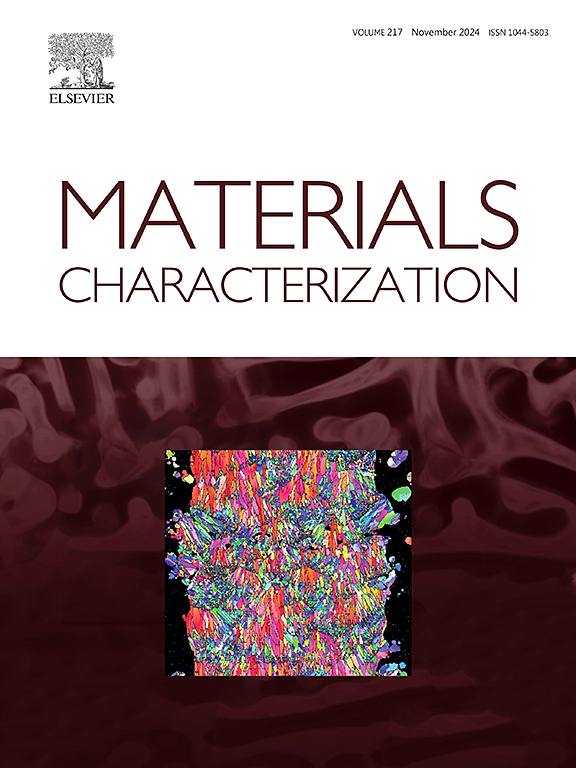微波辐照下钙稳定缺陷立方- zro2纳米材料
IF 4.8
2区 材料科学
Q1 MATERIALS SCIENCE, CHARACTERIZATION & TESTING
引用次数: 0
摘要
本研究的重点是利用钙(Ca)作为稳定元素,在微波照射下可持续合成二氧化锆(zirconia, ZrO2)纳米粉体,无需任何合成后处理。不同量的钙(3、7、10 mol%)的加入影响了ZrO2的相变和立方ZrO2的进一步稳定。采用x射线衍射(XRD)、拉曼光谱(Raman spectroscopy)、x射线光电子能谱(XPS)、扫描电子显微镜(SEM)、扫描透射电子显微镜(STEM)以及紫外可见光谱(UV-VIS)和光致发光光谱(PL)对合成的纳米粉体进行了分析。观察到有缺陷的立方ZrO2纳米晶体(约6 nm) (Ca含量为10 mol%),具有原子晶格畸变和表面台阶缺陷。较高的Ca含量还在PL上显示出额外的黄色发光带,这可能与本征缺陷或杂质有关。缺陷ZrO 2纳米粉的比表面积增加了151.62 m2/g,这是由于存在与结构缺陷相关的更小的纳米晶体。作为概念验证,将含有10 mol% Ca的纳米粉末浸渍到商业水过滤器中,以评估其在太阳辐射下从水中去除四环素的可持续和经济的光催化剂。本文章由计算机程序翻译,如有差异,请以英文原文为准。

Defective cubic-ZrO2 nanomaterials stabilized with calcium under microwave irradiation
The present study focuses on the sustainable synthesis of zirconium dioxide (zirconia, ZrO2) nanopowders using calcium (Ca) as a stabilizing element and microwave irradiation, eliminating the need for any post-synthesis treatment. The addition of different amounts of calcium (3, 7, and 10 mol%) influenced the ZrO2 phase transformation and further stabilization of cubic ZrO2. The synthesized nanopowders have been analyzed by X-ray diffraction (XRD), Raman spectroscopy, X-ray photoelectron spectroscopy (XPS), scanning electron microscopy (SEM), and scanning transmission electron microscopy (STEM), as well as by ultraviolet-visible (UV-VIS) and photoluminescence (PL) spectroscopies. Defective cubic ZrO2 nanocrystals (∼6 nm) were observed (10 mol% of Ca), featuring atomic lattice distortions and surface step defects. The higher amount of Ca also revealed an additional yellow luminescence band on PL, which can be related to intrinsic defects or impurities. The defective ZrO₂ nanopowder exhibited an enhanced specific surface area of 151.62 m2/g, which was attributed to the presence of smaller nanocrystals associated with structural defects. As a proof of concept, the nanopowder with 10 mol% Ca was impregnated into commercial water filters to be evaluated as sustainable and cost-effective photocatalysts for the removal of tetracycline from water under solar radiation.
求助全文
通过发布文献求助,成功后即可免费获取论文全文。
去求助
来源期刊

Materials Characterization
工程技术-材料科学:表征与测试
CiteScore
7.60
自引率
8.50%
发文量
746
审稿时长
36 days
期刊介绍:
Materials Characterization features original articles and state-of-the-art reviews on theoretical and practical aspects of the structure and behaviour of materials.
The Journal focuses on all characterization techniques, including all forms of microscopy (light, electron, acoustic, etc.,) and analysis (especially microanalysis and surface analytical techniques). Developments in both this wide range of techniques and their application to the quantification of the microstructure of materials are essential facets of the Journal.
The Journal provides the Materials Scientist/Engineer with up-to-date information on many types of materials with an underlying theme of explaining the behavior of materials using novel approaches. Materials covered by the journal include:
Metals & Alloys
Ceramics
Nanomaterials
Biomedical materials
Optical materials
Composites
Natural Materials.
 求助内容:
求助内容: 应助结果提醒方式:
应助结果提醒方式:


